AMD Ryzen Threadripper 7980X & 7970X Review: Revived HEDT Brings More Cores of Zen 4
by Gavin Bonshor on November 20, 2023 9:00 AM EST- Posted in
- CPUs
- AMD
- HEDT
- ThreadRipper
- Zen 4
- Threadripper 7000
- TRX50
TR 7000 vs. Intel: Power and Compile
Our previous sets of ‘office’ benchmarks have often been a mix of science and synthetics, so this time, we wanted to keep our office and productivity section purely based on real-world performance. We've also incorporated our power testing into this section. Given the nature and target market of the Ryzen Threadripper 7000 series, we've opted to focus on tasks such as compiling.
We are using DDR5-5200 RDIMM memory on the Ryzen Threadripper 7980X and 7970X as per JEDEC specifications. For Intel's Xeon W9-3495X, we are using DDR5-4800 RDIMM memory as per Intel's JEDEC specifications. It should be noted that both platforms are run with their full allocation of memory channels, e.g., TR7000 in 4-channel and Sapphire Rapids in 8-channel.
Below are the settings we have used for each platform:
- DDR5-5200 RDIMM - AMD Threadripper 7000
- DDR5-4800 RDIMM - Intel Xeon Sapphire Rapids WS
- DDR5-5600B CL46 - Intel 14th Gen
- DDR5-5200 CL44 - Ryzen 7000
Power
The nature of reporting processor power consumption has become, in part, a bit of a nightmare. Historically the peak power consumption of a processor, as purchased, is given by its Thermal Design Power (TDP, or PL1). For many markets, such as embedded processors, that value of TDP still signifies the peak power consumption. For the processors we test at AnandTech, either desktop, notebook, or enterprise, this is not always the case.
Modern high-performance processors implement a feature called Turbo. This allows, usually for a limited time, a processor to go beyond its rated frequency. Exactly how far the processor goes depends on a few factors, such as the Turbo Power Limit (PL2), whether the peak frequency is hard coded, the thermals, and the power delivery. Turbo can sometimes be very aggressive, allowing power values 2.5x above the rated TDP.
AMD and Intel have different definitions for TDP that are, broadly speaking, applied the same. The difference comes from turbo modes, turbo limits, turbo budgets, and how the processors manage that power balance. These topics are 10000-12000 word articles in their own right, and we’ve got a few articles worth reading on the topic.
- Why Intel Processors Draw More Power Than Expected: TDP and Turbo Explained
- Talking TDP, Turbo and Overclocking: An Interview with Intel Fellow Guy Therien
- Reaching for Turbo: Aligning Perception with AMD’s Frequency Metrics
- Intel’s TDP Shenanigans Hurts Everyone
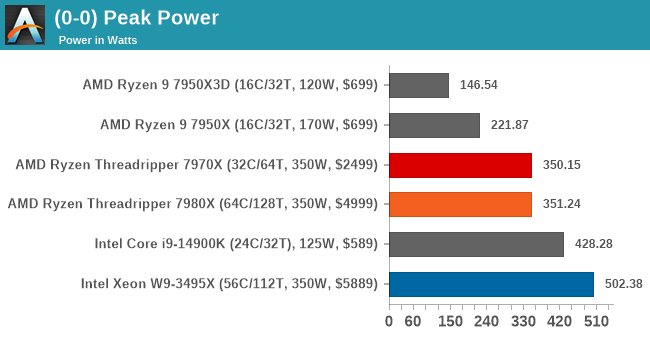
Looking at the max power we observed on the AMD Ryzen Threadripper 7980X and 7970X processors, we can see they hit and don't go robustly above their rated TDPs of 350 W. In contrast, the Intel Xeon W9-3495X peaked at a huge 502 W, well above the rated 350 W TDP. Compared to the desktop processors we've added to the data set, both Threadripper 7000 series processors are also considerably below the Intel Core i9-14900K.
Moving onto a deeper look at how the AMD Ryzen Threadripper 7980X compares to the Intel Xeon W9-3495X in Prime95 with Small FFTs, we can see that Intel's Sapphire Rapids WS option draws considerably more power. Despite having eight more cores than the W9-3495X, the Threadripper 7980X runs consistently within AMD's designated TDP of 350W; this is the TDP for all three AMD Ryzen Threadripper 7000 series SKUs. As we've highlighted in our desktop reviews of the Ryzen 9 7950X and Ryzen 9 7950X3D processors, we know AMD's Zen 4 core doesn't only deliver in performance, but it's a highly efficient core, too.
Compile/Database
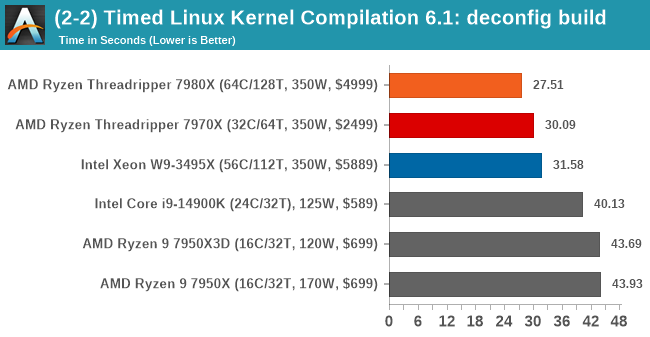
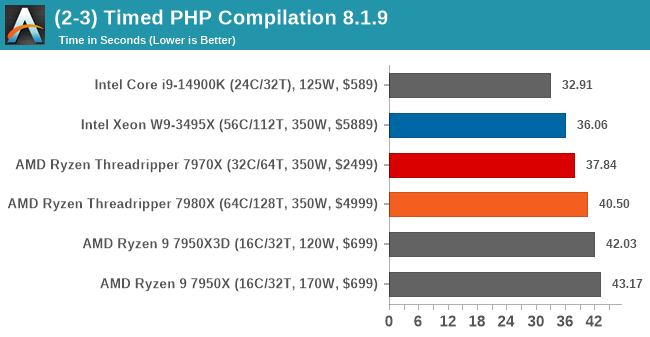
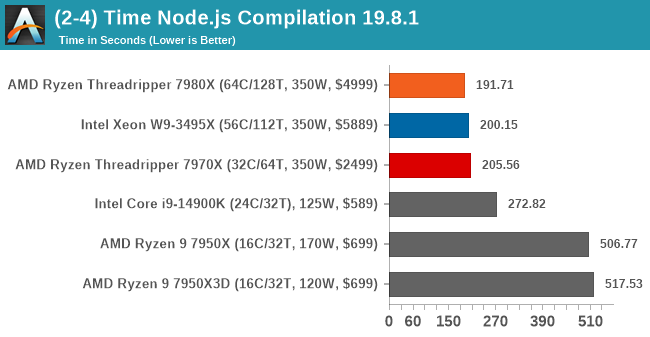
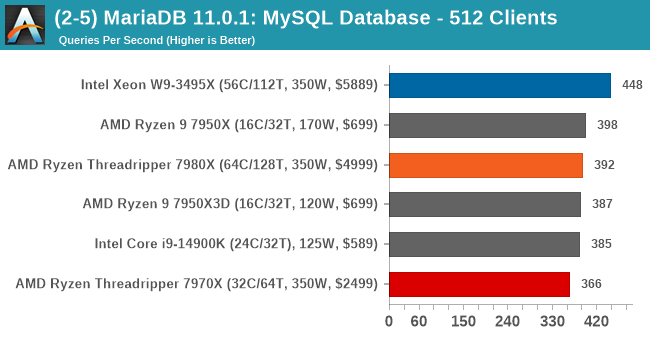
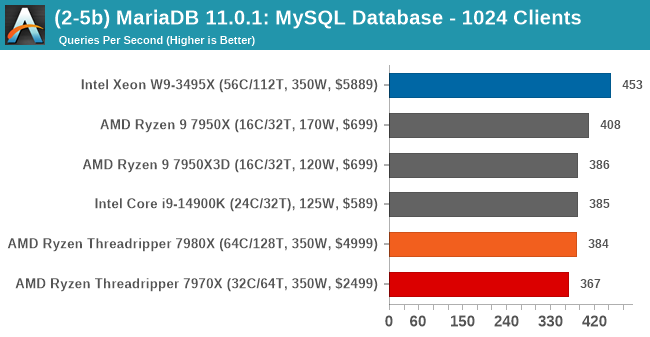
In our timed compilation benchmarks, including Linux Kernel, PHP, and Node.js, we can see that the Threadripper 7980X and 7970X perform well for the most part. In larger compilations such as Node.js, there's a significant advantage to having a higher core/thread count. Intel's Xeon W9-3495X beats all the chips we tested convincingly in the MariaDB MySQL database benchmark, with the flagship desktop chips also performing well here.


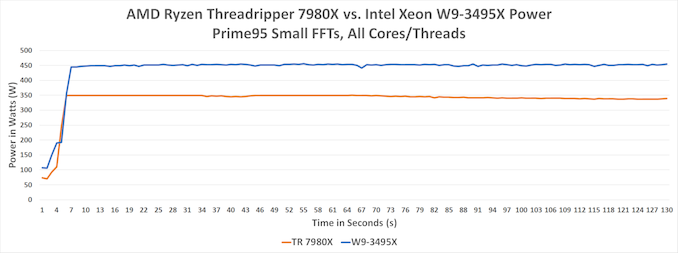








66 Comments
View All Comments
GeoffreyA - Thursday, November 23, 2023 - link
Yes. Deceptive everything.boozed - Monday, November 20, 2023 - link
"While it's clear in multi-threaded workloads such as rendering, the Ryzen Threadripper 7980X and 7970X are more potent with higher core counts, there are certain situations where the current desktop flagship processors still represent a better buy."Good to know if I ever start playing Dwarf Fortress?
FatFlatulentGit - Monday, November 20, 2023 - link
One test I'd like to see is encoding 4+ videos at once. One 4K AV1 or HEVC encode is not going to top out all of the cores on the 7980X, but enough parallel encodes will blast the thing.I also wouldn't mind seeing how they stack up against the WX series, especially in regard to RAM channels when the CPU is saturated.
garblah - Tuesday, November 21, 2023 - link
So, even with a 5,000 dollar CPU, encoding an hour of 1080p AV1 video at 30fps with the medium quality preset would take nearly 2 hours? I guess AV1 software encoding is still pretty slow.GeoffreyA - Tuesday, November 21, 2023 - link
Just raising the presets a few steps can cut down the time considerably, without too much of a loss of quality. On my system, SVT-AV1's fastest preset, 12, approaches x264 preset medium, if I remember right, and the quality is still better than the latter.GeoffreyA - Tuesday, November 21, 2023 - link
And preset 6, which is medium, is roughly similar to libaom's fastest, cpu-used 8.FatFlatulentGit - Tuesday, November 21, 2023 - link
A single AV1 encode is not going to saturate 64/128 cores. The advantage is being able to do multiple simultaneous encodes.GeoffreyA - Thursday, November 23, 2023 - link
Or splitting into scene-based chunks.SanX - Wednesday, November 22, 2023 - link
These new processors are just the BS and utter ripoff. Look at supercomputers which use very similar processors: You can find there a lot of different models and test them. What these tests show is that during simulations they almost always stay around base frequency which is for this article's 64-core 2.5GHz processor equivalent to 32-cores of standard consumer ~5 Ghz 7950x which costs ~$500. So you pay 10x money for just the 2x increase in performance. What is 2x increase in performance ? NOTHING! When you compare computers, remember, you compare not a salary, game fps or your weight loss :) stop thinking this way, in computers, and specifically in supercomputers it is 3-10x when things are really different. Typically if usual PC is really not enough for you then the next step you need is 10x or 100x more, or even 1000x. So these hell expensive toys have no economic sense for almost everyone. Just get supercomputer time if you need more than your PC gives you and stop wasting your money. By the way these processors made off $10 chiplets cost probably $100 to manufactureThunder 57 - Wednesday, November 22, 2023 - link
You're all over the place. First of all a 7950X has 16 cores. Even if tweo of those could match a 64 core TR (it won't), you'd need all of the other parts associated with a second computer. You are also forgetting about PCIe and memory bandwidth.Then you say maybe $100 to manufacture. You know how much it costs to develop these chips? AN insane amount of money. You make it sound like AMD is selling a $100 widget for $5000 because they can. People will buy these for $1000's. If they didn't sell, AMD would have to lower prices. The market will determine what is "fair".